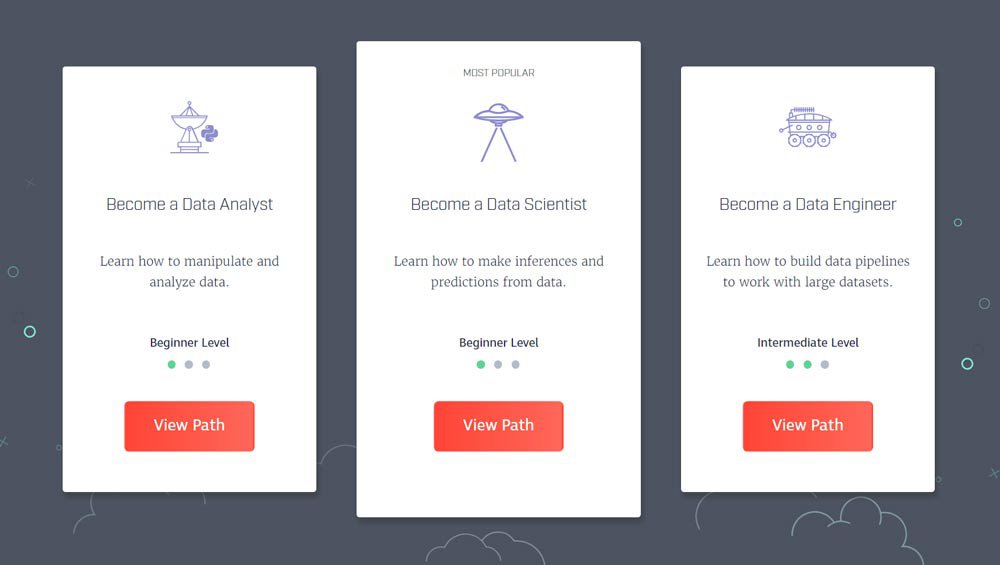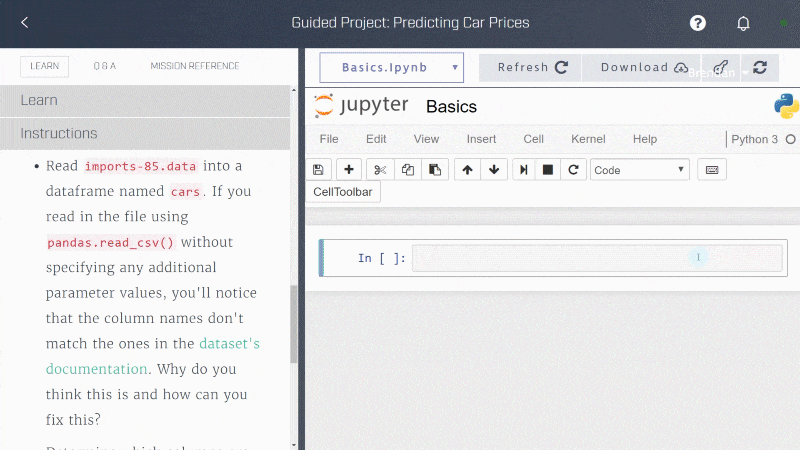
A Review of Dataquest's Data Science with Python Program
From just starting up a few years ago, Dataquest has become one of the most highly rated programs for data science.
LearnDataSci is reader-supported. When you purchase through links on our site, earned commissions help support our team of writers, researchers, and designers at no extra cost to you.

My experience learning online
Taking courses on sites like Coursera, edX, and Udemy are very helpful for the most part, but I have always felt like there was a component missing that was affecting my ability to learn effectively. Many times there are too many gaps and not enough guided application.
During college, the lecture wasn’t really where most of the learning happened. It was the long hours of problem sets, studying for tests, getting feedback, and the conversations with others about the material that really made my education. Dataquest replicates that experience online for learning data science.
Full disclosure: Dataquest has graciously agreed to share a percentage of sales that occur from this article. Any enrollments through links on this page will help fund the in-depth content produced by the writers and editors of LearnDataSci. Thank you in advance to anyone that chooses to support us!
Be aware, Dataquest isn’t like a normal course; it’s all reading and doing. You won’t find pre-recorded videos of teachers explaining any of the topics. Instead, all those concepts are explicitly written in a superbly constructed interactive textbook of sorts.
Maybe you’ve had this same experience, but I find it very easy to convince myself that I’m learning something simply because I ran through a few videos at 2x speed. With Dataquest, you don’t make any progress in the courses until you apply what you’ve learned, so you know exactly where you stand in terms of understanding the material.
This way of learning just works for me, but it’s also not the full picture. I think Dataquest is a great platform, but there are just some topics that I need to hear and see in order to really understand what’s going on.
In regards to machine learning concepts, Andrew Ng’s machine learning course was such a powerful aid in learning about the basic ML algorithms. I don’t think a read-only format like Dataquest would have been sufficient when I was first learning those first algorithms.
Another powerful example is 3Blue1Brown, an extremely well-produced YouTube channel that discusses a lot of math essential for ML, such as Linear Algebra, Calculus, and Neural Networks.
Finally, if you are in the market for some more reading material, I highly suggest picking up Introduction to Statistical Learning — hardcopy or free. ISLR is by far the best book to get you through the essential machine learning concepts, and it serves as a wonderful companion to courses (and Dataquest).
So with that, I find Dataquest to be an excellent resource that serves as a well-rounded learning base and workbook to backup the lectures of complex topics from various courses. Even at the free level, Dataquest is a great asset.
Let’s dig into their main offering.
Dataquest’s Data Science with Python Path
The data scientist path is very comprehensive and only assumes basic math. You’ll start out learning the basics of Python and make it all the way to making predictions with statistics and machine learning.
A lot of focus is put on actually implementing the math and not just importing a library. You’ll have to make functions to perform basic statistics, probability, and some machine learning tasks before you use the libraries.
The libraries you’ll eventually learn how to use are all from the ubiquitous data science stack: NumPy, SciPy, Pandas, Matplotlib, and Scikit-learn.
The other platforms I’ve joined have been missing many basic components, have lacked on theory, and aren’t challenging enough. Dataquest does a great job remediating those pitfalls. Concepts like data storytelling, effective use of command-line, and working with SQL are a few examples of Dataquest’s awareness of what data scientists need to know.
This path isn’t shy about the math either. There’s a good chunk of in-depth quests dedicated to probability, statistics, calculus, and linear algebra for data science and machine learning. Even in these parts, everything is applied and reinforced with code.
For machine learning, you’ll be learning the fundamental algorithms that all data scientists should know: K-Nearest Neighbors, Linear and Logistic Regression, K-means clustering, Decision Trees, and Neural Networks. All this is sprinkled with math and intuition behind each.
The founder of Dataquest put together this helpful video about learning data science which underpins the philosophy of Dataquest. In it, he breaks down exactly how to learn and what to learn, and is akin to the 80/20 rule applied to data science:
The 80/20 rule states that, for many events, roughly 80% of the effects come from 20% of the causes. — Wikipedia
Also, it’s worth noting that there are other paths available on Dataquest:
- Data Analyst in Python – a lighter version of the Data Scientist track
- Data Analyst in R – same as above but uses R programming instead of Python
- Data Engineer – all about working with large datasets and building pipelines. Deserves a review of its own!
What you’re paying for
If you haven’t made an account already (here), be aware that a full 1/3 of Dataquest’s material is Free. I would definitely recommend going through those first free courses first to see if you like the format and you feel like you’re learning.
You can learn a lot from the free sections, but here’s what’s in the premium version:
- All paths and missions
- All guided portfolio projects
- 1-on-1 office hours with data scientists
- Resume reviews
- Slack community – which is pretty active
Guided projects
The guided projects are not only meant to solidify your knowledge, but also to help build your portfolio and showcase your skills.

Guided projects are comprised of several steps, where each step is accompanied by a specific set of instructions to complete a task. In the first step, you’re usually met with a completely blank Jupyter notebook, and your goal is to answer questions about a dataset.
Office hours
A huge benefit of premium is being able to talk to data scientists about any hard questions or problems you’re having. This is a very similar experience to the data science mentors at Thinkful. If you’re curious how exactly office hours work and are scheduled, take a look at Dataquest’s knowledge base.
Pros and Cons
Dataquest is a fantastic platform, but there are some cons. Here’s a few points to consider:
Pros:
- Reasonably priced for the value
- Very comprehensive curriculum
- Interactive coding in browser — more challenging than other platforms
- Everything is focused on application as soon as possible
Cons:
- There were some bugs when interacting with some of the platform. For example, I was met with a dead iPython kernel when working on a guided project and needed to reload the page a few times.
- No videos
Is it worth it?
For $49/month, or $29/month for basic, not only do I think Dataquest is absolutely worth the price and time commitment, but I actually prefer it to any other method of learning online.
Unfortunately, I don’t think the certification is worth much to employers at this time, but the portfolio you build from Dataquest’s material is unquestionably one of the best signals you can send companies looking for data scientists.
When paired with videos from other data science courses — which are mostly free — Dataquest forms an intuitive and effective learning experience online.




